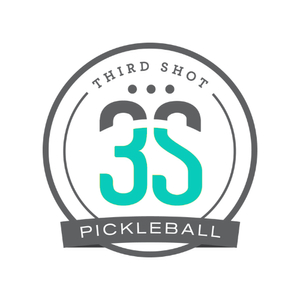Of all the pickleball lessons we give, one of the most sought after themes is being able to send balls with spin. People want their serves to be hit hard and high over the net, and then have topspin make it bite down into the court at the last second. They want their returns to have enough sidespin that they jump left or right as the opponent is preparing to hit a great third shot. They want their dinks to dip and their volleys to kick. In short, people are crazy about spin!
Tyson McGuffin hits a heavy topspin serve so his opponents struggle with the return.
But why this desire to be able to send balls with spin? It is because people think that their opponents are going to have trouble handling it. And they think this, often, because they themselves have trouble handling wildly spinning balls. So let’s dive in and figure out the best ways to handle the Spin-Master.
A Spin Primer:
Topspin. A ball spinning away from the hitter after being struck. Effects: Makes the ball drop sooner than if there was no spin. Increases the speed of the rebound causing it to jump toward the receiver sooner than expected.
Backspin. A ball spinning toward from the hitter after being struck, even as it moves away from them. Effects: Makes the ball ‘float’ longer than if there was no spin. Can cause the ball to skid after rebounding. Often stays lower than expected. On some surfaces, slows the rebound of the ball.
Sidespin. A ball spinning toward the left or right after being struck. Effects: Causes the ball to curve mid-flight and kick the same direction of the curve after the rebound.
Leigh Bradwell slices her third shot drop, making the fourth shop tougher to handle.
What To Do:
Time and space are your friend. One of the things that is tough about handling spinning balls is that it can be tricky to know not only which direction a ball is going to rebound, but how aggressively the spin will effect its trajectory. Even if you see the sidespin coming and know that it will kick left, you may not be certain how much of a kick it will take.
This is why it is helpful to give yourself some space between your body and the bounce. If you are quite close to the bounce then you won’t have much time to observe and adjust to the kick. If you are a little farther back, you’ll have a little more time (even a fraction of a second helps), to see what the ball is going to do.
Use speed. If your paddle is moving slowly as it comes into contact with a heavily spinning ball (for example when playing a drop) the spin will affect how the ball comes off the paddle face. You can lessen this by accelerating through the shot. This is why you see so many advanced players drive third shots when the return is hit with a lot of spin.
See what’s coming. If you don’t know you’re receiving a spinning ball before it gets to you, you’re going to have a lot of trouble handling it well. That’s why it is so important to see what your opponent is doing before and at contact. Are they swinging up on the ball, giving it topspin? Are they using a high-to-low swing path to make it have backspin? Or are the swiping across the back of the ball, giving it heavy sidespin? If you can see it coming in advance, you’ll be better prepared to handle it.
Bonus Tip: Make it harder for them to use spin in the first place. Hitting balls with lots of spin involves risk; moving the paddle face aggressively across the face of the ball increases the risk of misfiring. You can make it even harder for your opponent to be successful if the ball you send them is more challenging. This could be because you hit fast, make them run, jam them or even put a bunch of spin on the ball yourself! If you send a higher quality shot to them, they won’t have such and easy time being the Spin-Master they’d like to be.
Instructor Certification
Convenient. Affordable. Online. pcipickleball.com
As pickleball — and the paddles used to play it — continues to develop, we are going to continue to see spin used as an offensive tool. Whether it is the slicing return that skids off the bounce or the the offensive lob that manages to drop just inside the baseline, players will continue to find ways to use spin to their advantage. By paying more attention to the spin coming your way and giving yourself time and space to handle it, you can limit the amount of trouble spin causes you. Good luck!



